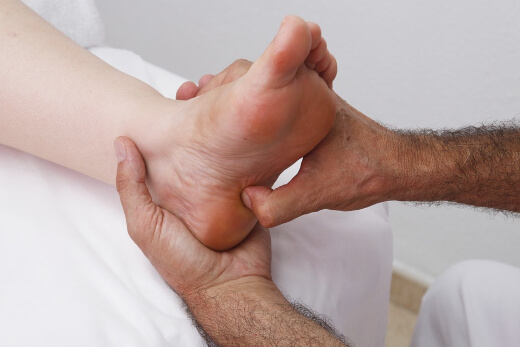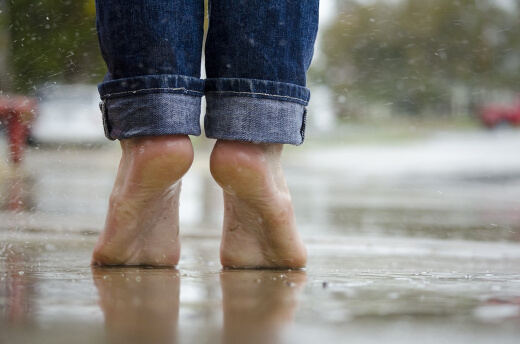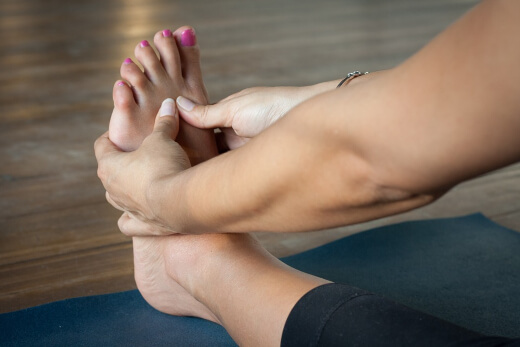
What is Plantar Fasciitis?
Plantar fasciitis is the most common cause of heel pain. It happens when the plantar fascia becomes swollen or irritated. The plantar fascia is the ligament that connects the front of your foot to the heel.
It is a weblike ligament that supports the arch and acts as a shock absorber.
Symptoms of Plantar Fasciitis
The most common complaint that comes along with plantar fasciitis is heel pain. It can be a dull or sharp pain. It usually affects one foot at a time but can affect both feet at once.
Pain is often the worse:
- When getting out of bed
- After resting for long periods
- After exercise
- Long periods of standing
Plantar Fasciitis Causes
Stress on the plantar fascia can cause small tears in the ligament. Repeated use of the ligament can irritate it causing inflammation and pain. However, the cause of plantar fasciitis is not always clear.
Some risk factors may increase the risk of developing plantar fasciitis:
Exercise
Exercises that put stress on the heel can be a contributing factor in developing plantar fasciitis.
Obesity
Being overweight will put added stress on your feet.
Age
People between the ages of 40 and 60 are more prone to it.
Occupation
Standing for long periods of time can damage the plantar fascia.
The Shape of Your Foot
When a person has high arches or flat feet their weight is not distributed properly. This can lead to additional stress on the plantar fascia.

Diagnosing Plantar Fasciitis
During your examination, your doctor will perform a physical exam of your foot. They will check for tenderness and the location of the pain.
During the evaluation, they may:
- Have you flex your foot.
- Look for redness or swelling.
- Test your reflexes.
- Check coordination and gate.
- Perform a muscle tone assessment.
- Check your balance.
Your doctor may also order imaging tests to rule out other problems such as fibromyalgia, sciatica, calcaneal stress fracture, posterior enthesopathies, among others.
Testing may include one or more of the following:
- X-ray
- MRI
- CT scan
- US
- NCV
- EMG
- Three-phase bone scan
- Neurosensory testing
Plantar Fasciitis Treatment
The majority of patients that have this recover with nonsurgical treatment. If nonsurgical treatment does not relieve symptoms surgery may be considered after 12 months.
Nonsurgical treatment consists of:
- Rest
- Plantar Fasciitis Exercises
- Ice
- Anti-inflammatory Medication
- Cortisone Injections
- Physical Therapy
- Supportive Shoes
- Orthotics
- Night Splints
- Extracorporeal Shockwave Therapy

Physical Therapy
Exercise rehabilitation plays an important part in recovering from plantar fasciitis. At Sydney Sports and Exercise Physiology, our exercise physiologists will work with you to customize an exercise routine that will help you recover faster.
Stiff muscles can make this condition worse. You can help relieve symptoms and prevent future pain by performing some of these plantar fasciitis stretches.
Standing Calf Stretch
Place your hands on the wall at chest level. Point your feet straight ahead. Place the affected leg/foot behind you. Keep your foot flat on the floor and the leg straight. Bend the front knee while continuing to keep the back foot flat against the floor.
You will feel a stretch in the back leg’s calf muscle. Hold the position for 30 to 45 seconds. Do 2 to 3 reps several times a day.
Towel Stretch
Sit with your leg straight out. Put a towel around your foot. Pull the towel towards you gently. You will feel a stretch in the calf muscle. Hold the position for 30 to 45 seconds. Do 2 to 3 reps several times a day.
Toe Extension
Cross your affected leg over the other leg. Grab your toes with one hand. Bend the toes and foot upwards. You will feel the stretch in the calf muscle. Take your other hand and massage the arch.
Hold the position for 10 seconds. Do 2 to 3 reps a few times a day.
Toe Curls
Put a marble or small towel on the floor. Using the affected foot, pick up the object by curling your toes. Do 10 reps a couple of times a day.
Wall Calf Stretch
Stand approximately two feet from the wall. Place the heel of the affected foot on the floor next to the wall with the ball of the foot on the wall. Gradually lean towards the wall while keeping your leg straight.
Hold the position for 30 to 45 seconds. Do 2 to 3 reps several times a day.
Arch Roll Massage
Sit down on a chair, but not all the way back. Using the affected foot roll a frozen can, frozen water bottle, or foam roller back and forth. Roll it for 1-3 minutes. Do this 2 times a day.
Complications for Plantar Fasciitis
Ignoring your it’s symptoms can lead to additional problems. Prolonged heel pain will change the way you walk. As a result, you can injure other areas of your body such as your legs, knees, hips and back.
The use of steroid injections may relieve pain, but they can weaken the ligament. When the plantar fascia ligament is weak, it can rupture.
Undergoing surgery has its own risks. You may experience nerve damage, an infection, bleeding, and adverse reactions to anesthesia. Surgery should be your last resort.
Preventing Plantar Fasciitis
There is no plantar fasciitis cure. There are a few lifestyle changes that you can make to help prevent plantar fasciitis.
- Avoid wearing high heels.
- Wear a shoe with good support.
- Replace athletic footwear often. They are only good for 350-500 miles.
- Keep a healthy weight.
- Do not go barefoot.
- Participate in low impact exercise.
- Avoid high impact exercises.
- Continue performing your exercises and stretches.
- Do not sleep with your sheets tucked in.
- Warm up before exercising.
- Eat a balanced diet.
- Stretch before you get out of bed.
- Massage your foot before getting out of bed.
Book an Appointment Now
If you are experiencing pain brought on by plantar fasciitis, we can help. Do not ignore the symptoms and hope that they go away on their own. At Sydney Sports and Exercise Physiology, our exercise physiologists will provide you with a personalised program based on your assessment.
The quicker you start physical therapy, the faster you will get rid of the symptoms of plantar fasciitis.
